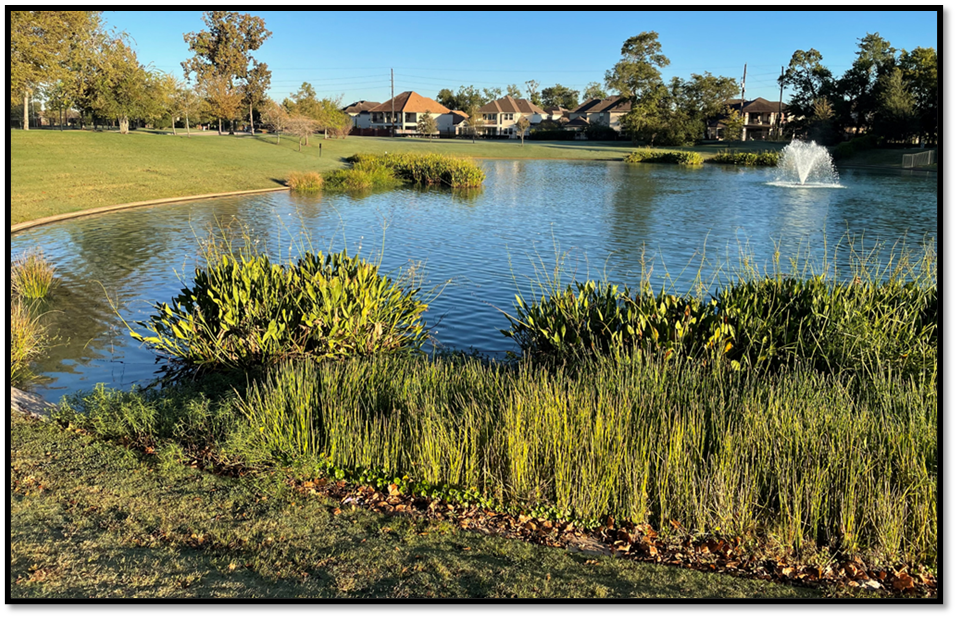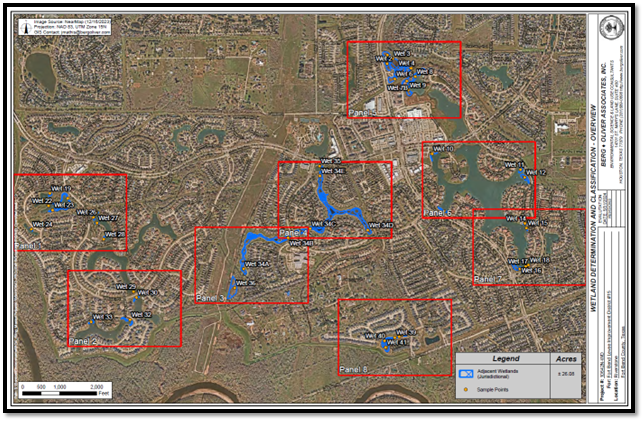Fort Bend County Levee Improvement District No. 15 (LID 15) is responsible for maintaining not only the community’s levees and drainage systems but also several protected wetland areas established under a United States Army Corps of Engineers (USACE) permit. These wetlands are not simply ornamental landscape features, they are federally protected ecological systems that play a vital role in water quality, flood control, and wildlife habitat.
Why Wetlands Exist in Riverstone
When the Riverstone community was developed, federal law required mitigation for impacts to existing natural wetlands and waterways. In 2005, USACE issued a permit authorizing construction of the levee and community infrastructure under Section 404 of the Clean Water Act. To offset impacts to natural wetlands, LID 15 was required to:
- Create and maintain 25 acres of new wetlands onsite within Riverstone’s lakes and drainage corridors.
- Preserve wetland corridors along Steep Bank Creek and Alcorn Bayou with permanent non-development deed restrictions.
- Project additional offsite conservation tracts, ensuring long-term ecological balance and compliance with federal environmental standards.
These measures ensure that for every acre of wetland affected by development, new or enhanced wetlands are provided in perpetuity, creating the mosaic of aquatic plant beds and naturalized edges residents see today around Riverstone’s lakes and trails.
The Purpose of Wetlands
Wetlands act as nature’s water filters and stormwater buffers. Within LID 15, they:
- Improve water quality by trapping sediment and absorbing nutrients before they enter downstream waterways.
- Reduce flood risk by slowing and holding storm runoff, which helps regulate water levels in connected lakes and channels.
- Provide habitat for fish, birds, pollinators, and other wildlife species native to the Brazos River floodplain.
- Enhance biodiversity and aesthetics, especially as native plants mature and seasonal changes bring variation in color and texture.
Why Wetlands Look “Less Manicured”
One of the most common questions received by residents is “why do these areas look overgrown compared to other parts of Riverstone?”
The answer lies in the permit restrictions. Under USACE regulations and the District’s adopted Operation and Maintenance Procedures for Wetland Preservation Areas and Stream Channels, these areas must remain in a naturalized state.
That means:
- The District cannot mow or clear vegetation the way it does in park spaces or along open trails.
- Native plant communities must be allowed to grow to maintain the correct “roughness coefficient” for stormwater flow and habitat quality.
- Maintenance is limited to selective removal of invasive or obstructive species such as Chinese tallow, privet, or excessive cattail growth, using non-intrusive methods like hand removal or targeted herbicide treatment.
- No soil disturbance or heavy equipment is allowed within or below the ordinary high-water mark unless it’s necessary to restore drainage conveyance after a storm.
These requirements ensure compliance with federal environmental law while preserving the ecological function of the wetlands.
Maintenance and Seasonal Appearance
Wetland maintenance follows strict, environmentally sensitive guidelines. LID 15’s maintenance contractor conducts routine inspections and performs seasonal work approved by the District’s environmental consultants:
- Monthly mowing of the perimeter areas to control weeds and maintain visibility.
- Annual interior maintenance, typically in late summer, using lightweight or hand-held equipment to remove invasive growth.
- Seasonal hand trimming in early spring to remove dead or wilted vegetation left from winter freezes.
Many of the desirable native plants go dormant after hard freezes, causing them to appear brown or wilted until warmer temperatures return. Once spring arrives, maintenance crews trim back the dead material and relocate healthy native plants from densely vegetated areas to other beds to maintain balance and improve appearance. This cycle of dormancy and regrowth is completely natural and essential for maintaining a healthy wetland ecosystem.
What Residents Can and Cannot Do
Because these are regulated wetlands, residents should take care not to disturb them. The following guidelines are based on LID 15’s adopted O&M Procedures and the federal permit requirements:
Allowed:
- Enjoying the trails, lakes, and views of wetland areas
- Reporting issues such as fallen trees, erosion, or trash to the District’s management team: https://www.fblid15.com/contact-us/
- Supporting native wildlife by avoiding chemical runoff (like fertilizers or pesticides) near lake edges.
Not Allowed:
- Planting, mowing, or removing vegetation within the wetland or its buffer.
- Dumping grass clippings, tree trimmings, or soil in wetland areas.
- Constructing walkways, decks, fences, or landscaping that encroach into the wetland buffer without prior approval from the District and its environmental consultants.
- Applying herbicides, pesticides, or fertilizers directly to the wetland or adjacent lake edge.
Unauthorized disturbance could violate federal regulations and compromise the District’s permit compliance.
A Shared Responsibility
The wetlands throughout Riverstone are an integral part of the District’s flood protection and environmental stewardship system. Their natural look may differ from manicured park landscapes, but every grass and native bloom contributes to a healthier, more resilient community.
Residents can help by respecting the protected areas, reporting concerns to the District, and understanding that these wetlands, though sometimes wild in appearance, are functioning exactly as they were designed: to protect the community, improve the waterways, and preserve native Texas ecosystems for generations to come.



